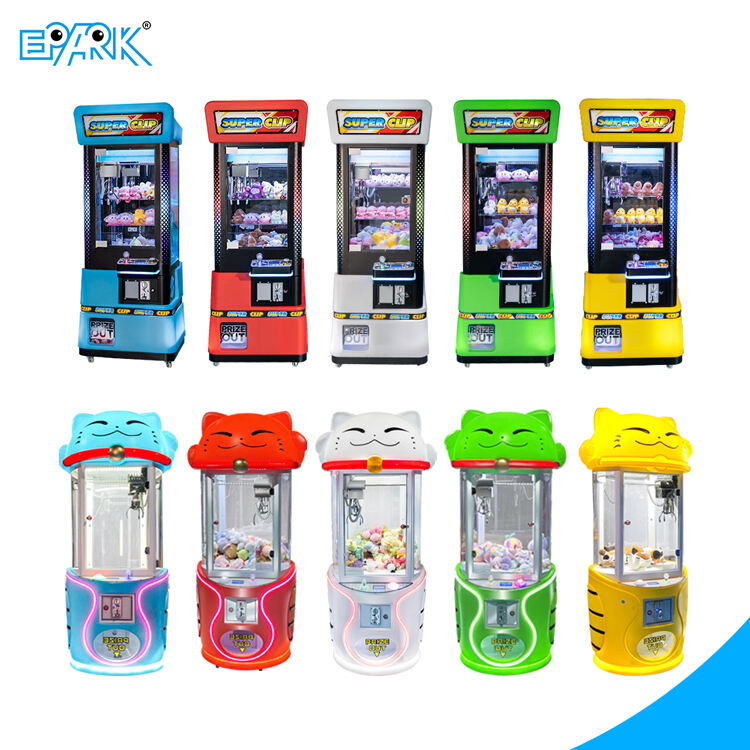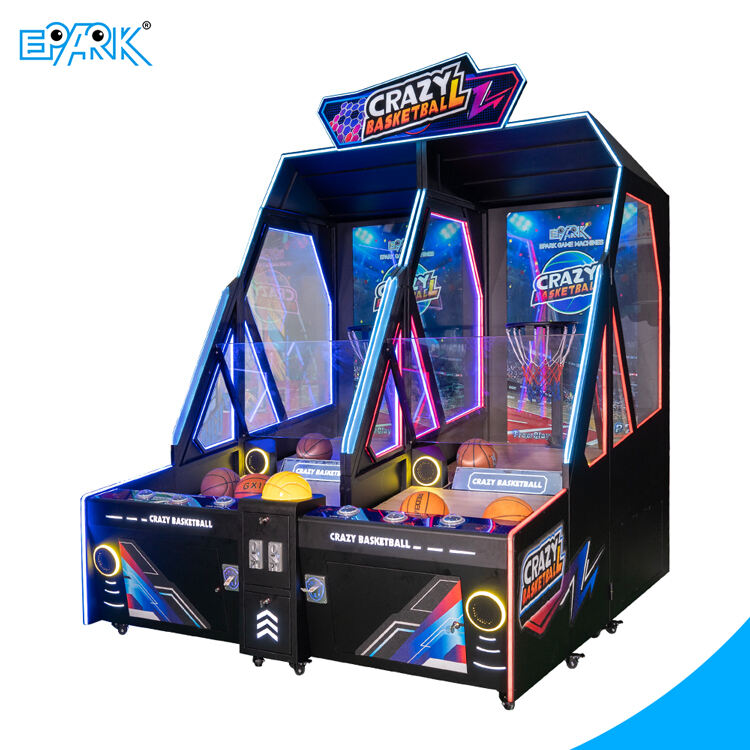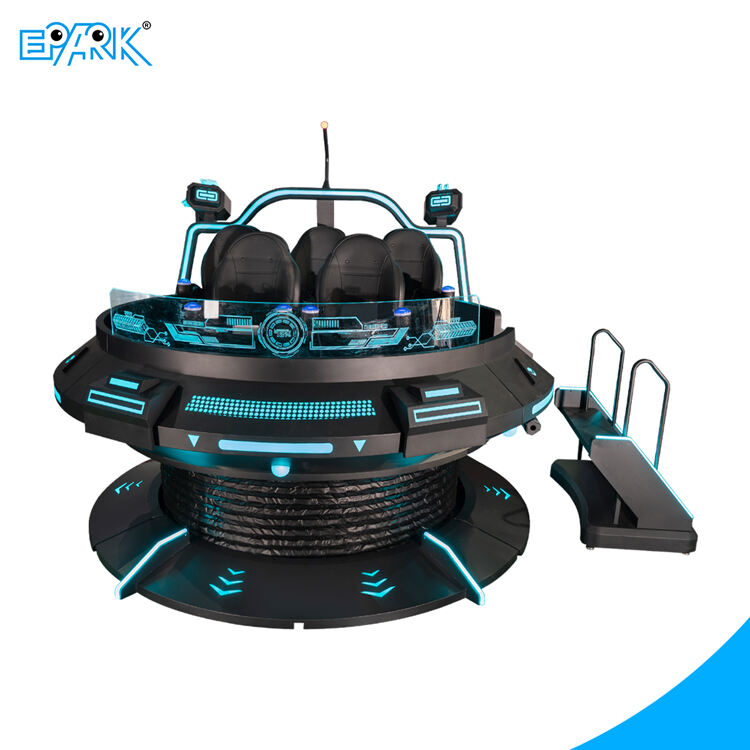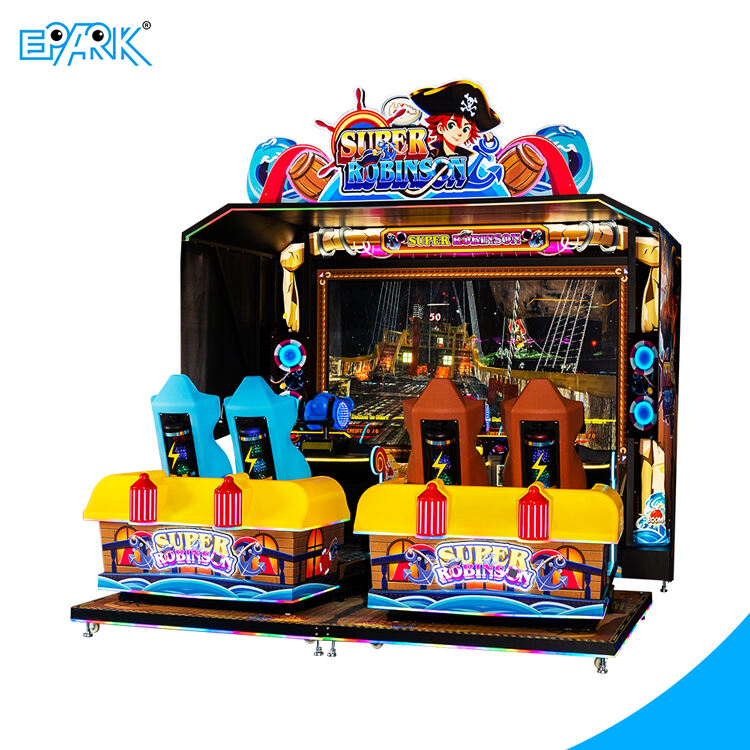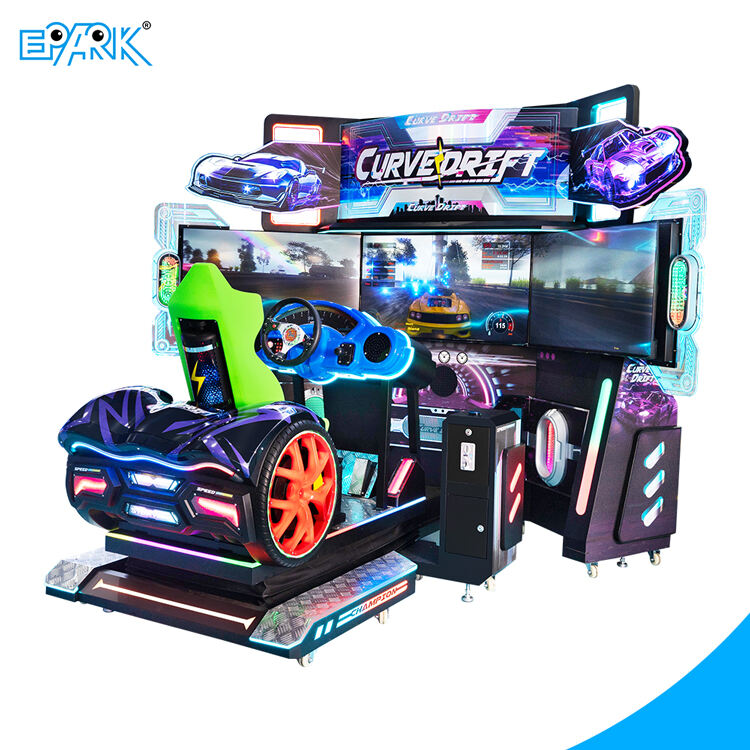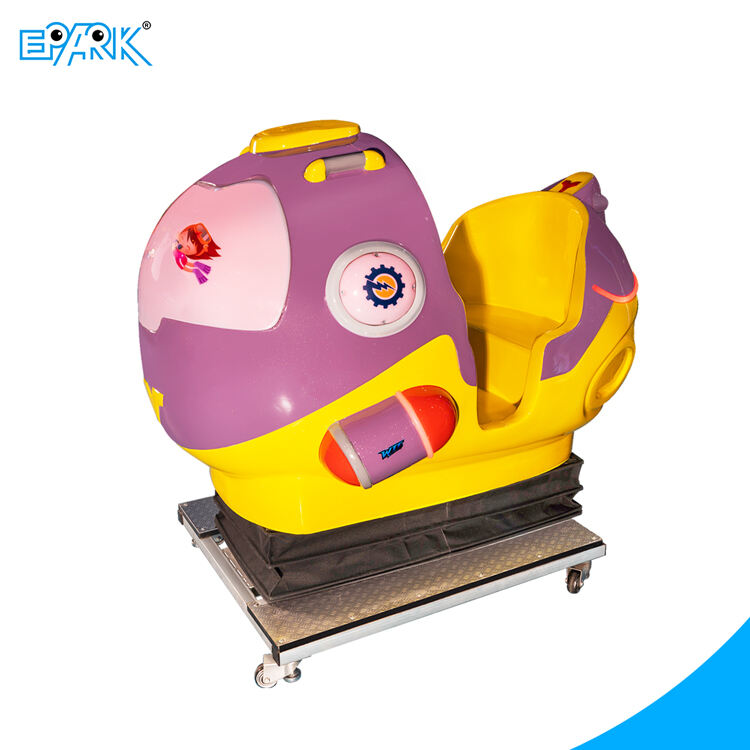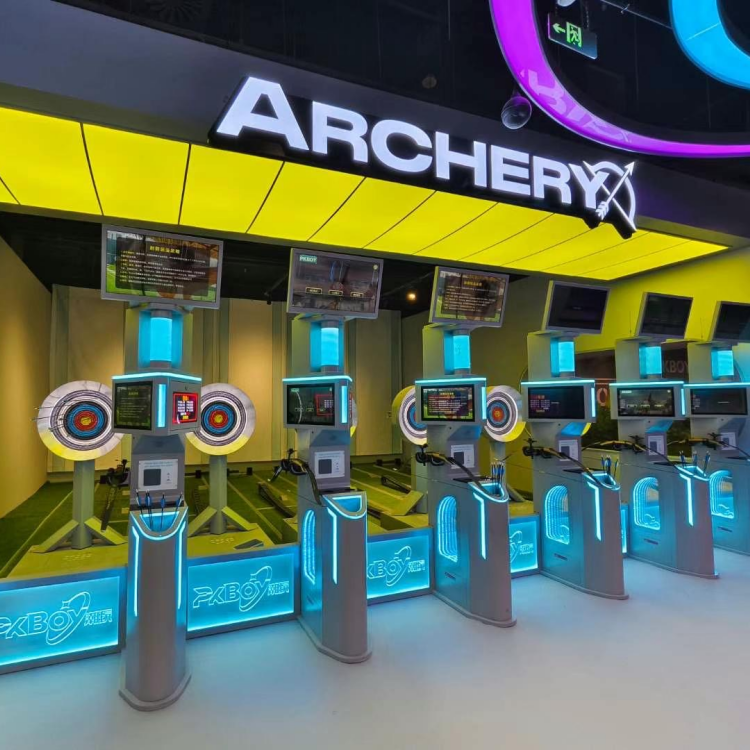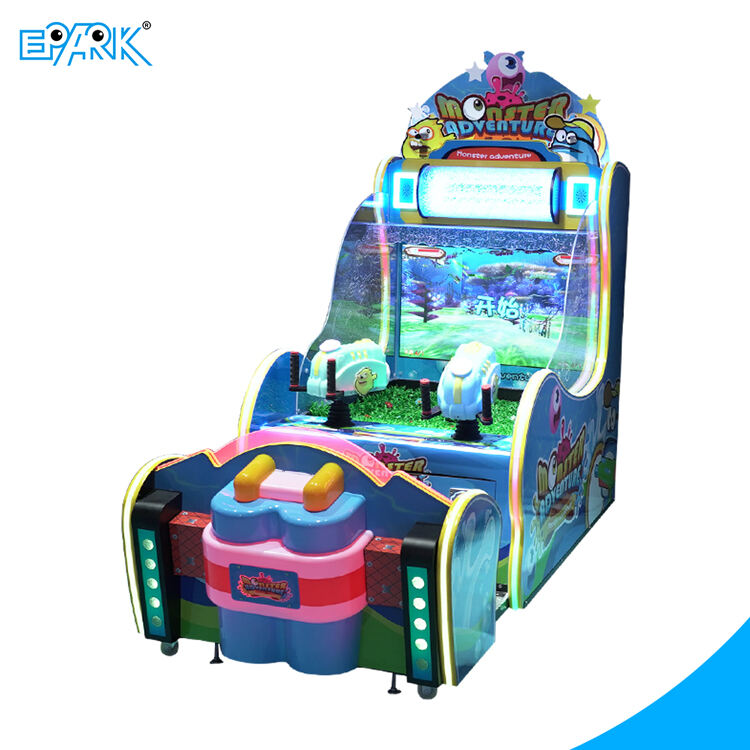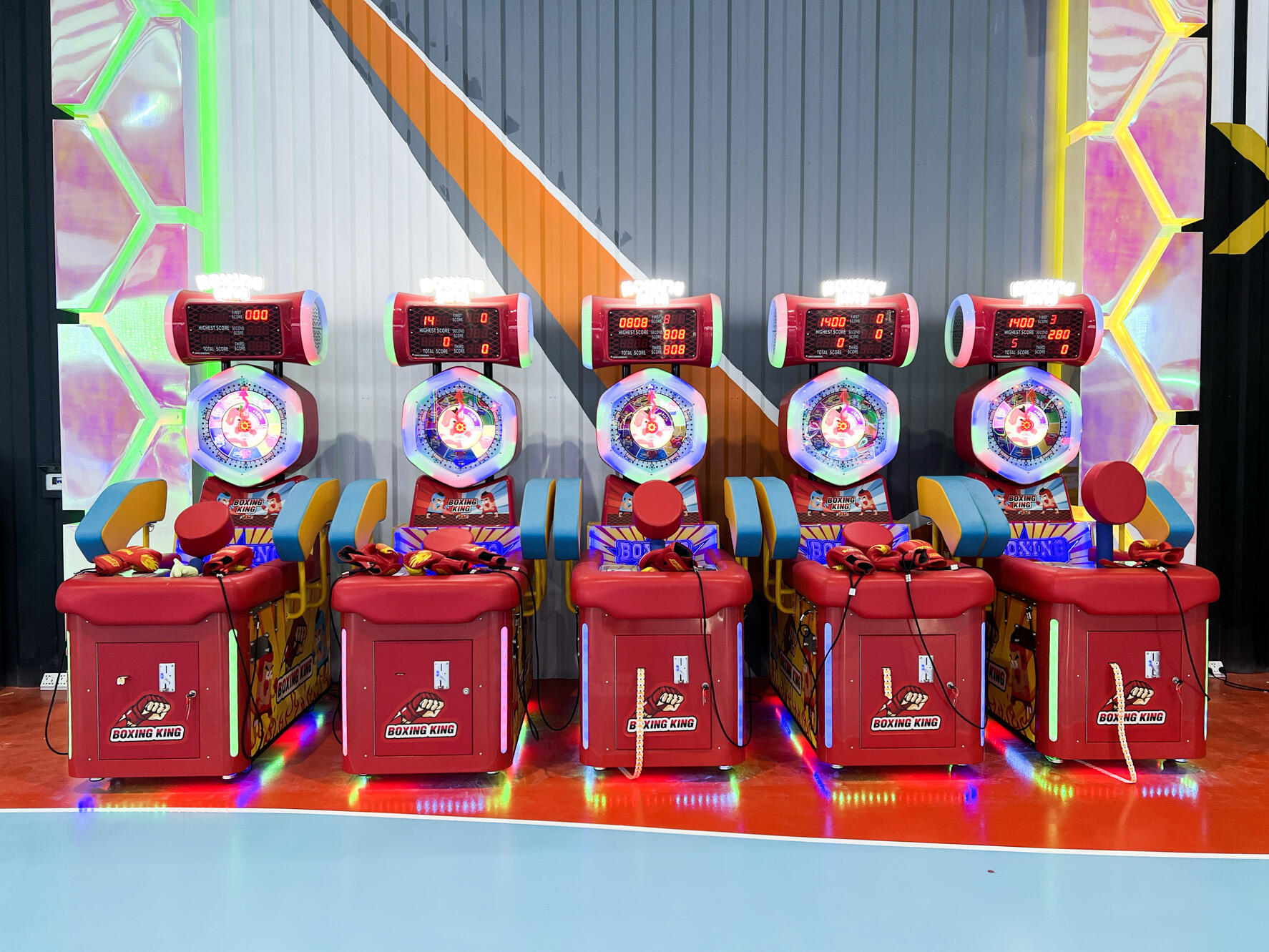डेटोना USA से मॉडर्न सिमुलेटर्स तक
रेसिंग प्ले में एक नया मानक स्थापित करते हुए, डेटोना यूएसए 1993 में लॉन्च किए जाने पर अब तक की सबसे आकर्षक और आगे वाली आर्केड परिवहन अनुभव थी, और इसकी विरासत ने बाद में आने वाले कई खेलों को आकार दिया। डेटोना यूएसए अपने लगभग वास्तविक जीवन जैसे दिखावट और अंतर्ज्ञानी फोर्स फीडबैक स्टीयरिंग के साथ दुनिया भर के आर्केड में एक उल्लेखनीय दृश्य थी। इससे आर्केड रेसिंग की शैली की शुरुआत हुई, जो आज के हाइपर-रियलिस्टिक सिमुलेटर के युग तक विकसित हो चुकी है। तकनीकी प्रगति ने इन मशीनों के ग्राफिक्स और यांत्रिकी में काफी सुधार किया है, जिससे खिलाड़ियों के लिए गेमिंग अनुभव वास्तव में रोमांचक बन गया है। इस शैली के विकास में इनिशियल डी और मारियो कार्ट आर्केड जीपी जैसे खेल बहुत महत्वपूर्ण रहे हैं, जिन्होंने नए विचारों और गेमप्ले की गहराई को शामिल किया। आर्केड मशीनों की बिक्री में रेसिंग खेलों की बढ़त दिखाई दे रही है, जो आर्केड प्रेमियों के लिए इस आर्केड रेसिंग एक्शन के प्रति सकारात्मक प्रवृत्ति दर्शाती है!
फोर्स फीडबैक ने कैसे वर्चुअल रेसिंग को बदला
रेसिंग आर्केड मशीनों में फोर्स फीडबैक तकनीक के उपयोग ने उद्योग में एक महत्वपूर्ण परिवर्तन साबित किया है। यह वास्तविक समय में फीडबैक प्रदान करने की नवाचार के कारण है, जिससे खिलाड़ियों को अब ऐसे दबाव, धक्के और मोड़ महसूस होते हैं, जैसे कि वे एक कार चला रहे हों। विशेषज्ञों का कहना है कि फोर्स फीडबैक की यह विशेषता वर्चुअल रेसिंग की एक महत्वपूर्ण सीमा, जिसे अनुभव की कमी कहा जाता है, को दूर करने में सक्षम रही है। इसका कारण यह है कि लोगों को यह महसूस नहीं हो पाता था कि रेसिंग कार ड्राइवर को रेस ट्रैक पर क्या अनुभव होता है। यह तकनीक आर्केड सेटअप में गेमिंग उद्योग को बदलने में सक्षम रही, खासकर लोकप्रिय गेम्स जैसे ग्रैन टरिस्मो में, जहां खिलाड़ियों को अब गेम और आर्केड रेसिंग में कोई अंतर नजर नहीं आता। वे योग्यता प्राप्त करने में व्यस्त हैं ताकि मशीन का अनुभव प्राप्त किया जा सके। परिणामस्वरूप आर्केड सेटअप को अपने गेमिंग स्थान के रूप में बनाया गया, क्योंकि यह रेसिंग को तीव्र और मजेदार बना दिया।
LSI एकीकरण: खेलने के इतिहास में आर्केड मशीनें
लैटेंट सेमैंटिक इंडेक्सिंग (एलएसआई) गेमिंग की दुनिया को मैप करने और अन्यथा अलग-अलग एर्केड गेम शैलियों को बड़े एर्केड मशीन आर्क के विभिन्न नोड्स के रूप में जोड़ने का एक बेहतरीन तरीका है। एलएसआई रेसिंग गेम, एयर हॉकी गेम और डांसिंग गेम जैसे खेलों के बीच संबंध स्थापित करने में सक्षम बनाता है, उनकी खोज की सुविधा प्रदान करता है और डिजिटल युग के लिए उनकी प्रासंगिकता बढ़ाता है। एर्केड कैबिनेट गेमिंग संस्कृति के सर्वश्रेष्ठ रूप के प्रतीक हैं, उस सब कुछ को समेटे हुए हैं जिसने गेमिंग के स्वर्ण युग को वास्तव में अद्वितीय बनाया था। उनमें से अधिकांश केवल खराब गेम हैं। डेटोना यूएसए जैसे रेसिंग गेम्स की शुरुआती तेजी से बढ़त से लेकर मुक्केबाजी एर्केड गेम्स जैसे अन्य बड़े आकर्षणों तक, यह मशीनें हमेशा से प्रशंसकों और संग्राहकों के लिए आश्चर्य का स्रोत रही हैं, और कम से कम कहें तो गेमिंग इतिहास के महत्वपूर्ण हिस्से हैं।
Sega Ferrari F355 Challenge: सोने की मानक
यह सेगा की बेहतरीन रचना आर्केड रेसिंग गेम्स में एक मील का पत्थर है, अपने नवाचारी गेमप्ले और यथार्थवादिता के कारण। लेट निन्टीज़ में लॉन्च किया गया, यह एक गेम चेंजर था जब इसने एक ऐसे कैबिनेट के माध्यम से रूबरू कराया जो एक शीर्ष श्रेणी की स्पोर्ट्स कार के अंदरूनी हिस्से जैसा दिखता था, जिससे पूर्ण आभासी डूबने का अनुभव और यथार्थवादिता में वृद्धि हुई। इस गेम में उन्नत ग्राफिक्स और तत्काल गेमप्ले थे जो अपने समय से आगे थे और एक तरह के सिमुलेटर जैसा अनुभव देते थे। आर्केड संग्राहकों और उद्योग के हस्तियों की टिप्पणियों में यह बात सामने आई है कि यह दुनिया भर में लोकप्रिय था और आर्केड गेमिंग के इतिहास में एक महत्वपूर्ण भूमिका निभाया। फेरारी एफ355 चैलेंज अभी भी उन खेलों में से एक है जो इस बात को दर्शाता है कि कैसे कैबिनेट डिज़ाइन और तकनीक आर्केड में रेसिंग गेम्स के साथ खिलाड़ियों की बातचीत को कैसे बदल सकती है।
क्रूज़िन' ब्लास्ट और मल्टीप्लेयर मेयहम
क्रूइसन ब्लास्ट ने नई पीढ़ी के प्रशंसकों के लिए शानदार ट्रैक डिज़ाइन, सड़क कानून के अनुकूल ना होने वाले बड़े वाहनों, बूस्ट-युक्त दौड़ और उच्च-प्रभावशाली हथियारों के खेल के साथ क्लासिक आर्केड रेसिंग श्रृंखला को नया जीवन दिया। इस खेल की एक प्रमुख आकर्षण विशेषता अन्य खिलाड़ियों के खिलाफ खेलने की क्षमता है, जिससे आर्केड के साथ जुड़े प्रतिस्पर्धी (और गैर-सामाजिक) स्वभाव को बरकरार रखा जाता है। खेल में तीव्र गति और भावनात्मक, विनाशकारी दृश्यों का एकीकरण इसे स्थानीय आर्केड में दोस्तों की टीमों के लिए आवश्यक खेल बना दिया। खिलाड़ियों और समीक्षकों द्वारा अक्सर क्रूइसन ब्लास्ट का उल्लेख इसके मज़ेदार और रोमांचक सामाजिक खेल के लिए किया जाता है, क्योंकि यह वह खेल था जिसने आर्केड रेसिंग की दुनिया में मल्टीप्लेयर गेमप्ले लाकर नए रास्ते खोले। इसकी प्रसिद्धि समुदाय की प्रतिक्रिया के माध्यम से फैली और इसे अनौपचारिक खिलाड़ियों और आर्केड जाने वालों के लिए एक शानदार क्लासिक बना दिया।
फास्ट एंड फ्यूरियस: सुपरकार्स – फिल्मों और एर्केड के बीच पुल
फास्ट एंड फ्यूरियस: सुपरकार्स आर्केड फास्ट एंड फ्यूरियस श्रृंखला के उत्तेजक रोमांच और अंतरराष्ट्रीय आकर्षणों को लेकर आती है और प्रशंसकों और गेमर्स के लिए फिल्मों में देखी गई रफ्तार और उत्तेजना को दोहराने के लिए एक अनुपम सवारी तैयार करती है। फास्ट एंड फ्यूरियस फिल्म श्रृंखला की सफलता और लोकप्रियता का लाभ उठाते हुए, इस आर्केड खेल में ऐसे पात्र शामिल हैं जिन्होंने पहली बार फास्ट एंड फ्यूरियस: सुपरकार्स और द फास्ट एंड द फ्यूरियस ड्रिफ्ट में अपनी शुरुआत की थी। फास्ट एंड फ्यूरियस सुपरकार्स में नए फीचर्स, बेहतर ग्राफिक्स और अधिक "एक्शन" जैसी विशेषताओं को शामिल किया गया है। शानदार आंकड़ों और शीर्ष खिलाड़ियों की भागीदारी के साथ, यह खेल फिल्मों के जादू को सफलतापूर्वक कैद करने में कामयाब रहा है और कुछ ऐसा अद्वितीय और अंतरक्रियात्मक बनाया है। इसलिए, एफ एंड एफ: सुपरकार्स गेम उद्योग में एक बहुत विशिष्ट घटना बनकर उभरा है, जहां फिल्म की दुनिया आर्केड जाने वाले व्यापक वर्ग के बीच लोकप्रिय है।
ट्रिपल-स्क्रीन डिप्लोइमेंट और 4K डिसप्ले
पिछले कुछ वर्षों में, स्क्रीन तकनीक की नवीनतम पेशकारी के साथ रेसिंग आर्केड्स में क्रांति आ गई है। ट्रिपल-डिस्प्ले के द्वारा आप पूरी तरह से रेस में डूब जाते हैं और ड्राइवर के दृश्य को पहले की तुलना में बेहतर तरीके से प्रतिबिंबित करते हैं; अन्य विशेषताओं में एक पुनर्बलित स्टील केंद्रीय स्तंभ शामिल है और रेसिंग व्हील्स को माउंट किया जा सकता है, और व्हील-प्लेट कोण समायोज्य है। यह परिवर्तन इन खेलों के लिए दृश्य वास्तविकता के मामले में एक बड़ा सुधार रहा है और यह देखने में अधिक वास्तविकता लाने में सहायता कर रहा है। इसके अलावा, हर किसी को पसंदीदा आर्केड रेसिंग गेम 4K रिज़ॉल्यूशन के साथ एक नए स्तर पर ले जाता है, प्रत्येक पसीने की बूंद और तेल की बूंद को 60fps पर प्रस्तुत करते हुए। कार में सबसे गर्म गाना शामिल है, और फ्यूजन स्टेज पर सबसे गर्म ट्रैक; अधिक प्रत्यक्ष संगीत के साथ। तकनीकी समीक्षाओं और खिलाड़ियों की प्रतिक्रियाओं में अक्सर दिखाई देता है कि सुधार स्वयं अत्यधिक तल्लीन करने वाले हैं, और दृश्य गुणवत्ता में वृद्धि के साथ और स्ट्रीमिंग संक्रमण बिल्कुल निर्बाध हैं। ये सुविधाएं केवल खिलाड़ियों को खेल में तल्लीन करने में मदद नहीं करती हैं, बल्कि आर्केड कैबिनेट्स के लिए वास्तविकता का एक नया मानक भी स्थापित करती हैं।
पेडल प्रणाली और वास्तविक गियर शिफ्टर
एरकेड रेसिंग गेम्स में फोर्स फीडबैक नियंत्रण के विकास ने गेमिंग प्रौद्योगिकी में वास्तविकता के स्तर को बढ़ाने के लिए एक समग्र अतिरिक्त मापदंड जोड़ा है। आज के रेसिंग एरकेड में विस्तृत पेडल तंत्र और सटीक गियर शिफ्टर्स की सुविधा होती है, जो खेल को ड्राइविंग के समान बनाकर अधिक रोमांचक बनाते हैं। अब खिलाड़ी इन तत्वों की बनावट महसूस कर सकते हैं और परिणामस्वरूप उन आभासी कारों के साथ अधिक जुड़ाव महसूस करते हैं जिनकी वे दौड़ रहे हैं, जो समग्र खेलने की संतुष्टि में सकारात्मक रूप से योगदान करता है। उपयोगकर्ता उद्धरण: उपयोगकर्ता लगभग अपरिवर्तनीय रूप से उत्कृष्ट नियंत्रणों द्वारा प्रदान किए गए उत्साह और वास्तविकता के बारे में बात करते हैं (विशेष रूप से यदि ये वास्तविक जीवन के गेम भौतिकी पर आधारित हैं)। विशेषज्ञ भी सहमत हैं कि अच्छे नियंत्रण एरकेड दौड़ों को अधिक रोमांचक और मनोरंजक बनाते हैं। जबकि यह सभी खिलाड़ी के अनुभव को बढ़ाने के बारे में है जिसमें अधिक सहज और प्रतिक्रियाशील नियंत्रण प्रणालियों की आपूर्ति की जाती है, निर्माता ड्राइविंग और सिम रेसिंग क्षेत्र में वास्तविक और आभासी के बीच की सीमा को धुंधला करना जारी रखते हैं। डिज़ाइन के साथ प्रौद्योगिकी का यह संगम एरकेड गेमिंग की प्रगति में अगला तार्किक कदम है।
प्रतिस्पर्धा को हवा हॉकी और डांस गेम्स के साथ संतुलित करना
रेसिंग आर्केड तब सबसे अच्छा प्रदर्शन करते हैं जब उन्हें एक मिश्रित प्रस्ताव के रूप में पेश किया जाता है, जिसमें एयर हॉकी और डांस मशीन जैसे लोकप्रिय आर्केड गेम्स शामिल होते हैं, जिससे एक सक्रिय और विविध मनोरंजन क्षेत्र बनता है। आर्केड गेम्स की इस विविधता के साथ, स्थान विविध दर्शकों को आकर्षित करने और विभिन्न गतिविधियां प्रदान करने में सक्षम होते हैं, "हर किसी के लिए कुछ न कुछ"। प्रतिस्पर्धी रेसिंग आर्केड गेम्स का संयोजन और अन्य प्रतिस्पर्धी या समान रूप से शानदार आर्केड गेम्स आर्केड अनुभव को समृद्ध करने के लिए बेहतरीन होते हैं और रंगारंग छटा लाते हैं और दोनों हाई स्कोर के गौरव के अवसर और भीड़ के जमावड़े के साथ-साथ लाइन में लोगों की भीड़ के लिए बड़ी संभावनाएं होती हैं जो एक दूसरे से दौड़ना चाहते हैं। उद्योग के रुझान साबित करते हैं कि विविध और मल्टी-प्लेयर गेमिंग अनुभवों का मूल्य विभिन्न आयु और योग्यता के लक्षित दर्शकों को एक साथ खेल में भाग लेने के लिए प्रेरित करता है, जो सहयोग और प्रतिस्पर्धा की कला को जोड़ता है।
एरकेड मशीन क्लस्टर्स की सामाजिक आकर्षण
आर्केड रेसिंग को आकर्षक बनाने वाला एक अन्य सांस्कृतिक या सामाजिक तत्व मशीनों की व्यवस्था में निहित है। किसी दिए गए स्थान में मशीनों का समूह खिलाड़ियों के लिए कई स्तरों पर महत्वपूर्ण प्रोत्साहन के रूप में कार्य करता है। सबसे पहले, स्पर्धा का खेल जैसा रूप - खिलाड़ियों का एक दूसरे के सम्मुख होना और आपस में अपने स्कोर देखना - स्वयं में मनोरंजन की तलाश में आए लोगों को आकर्षित करता है। इसके अतिरिक्त, ये समूह समकालिक और असमकालिक दोनों प्रकार की स्पर्धा के लिए अधिक संभावित स्थान भी प्रदान करते हैं: या तो एक बड़ा समूह खेल में योगदान दे रहा होता है, एक दूसरे के उच्चतम स्कोर को पार करने का प्रयास कर रहा होता है, या फिर खिलाड़ियों द्वारा सक्रियता से एक साथ या एक दूसरे के विरुद्ध खेला जा रहा होता है। ये कारक अक्सर समुदायों, प्रशंसकों के समूहों और नियमित ग्राहकों के विकास की ओर ले जाते हैं। शोध से पता चलता है कि किसी दिए गए स्थान की सामाजिकता का सेवाओं या उत्पादों के साथ संतुष्टि से सकारात्मक सहसंबंध होता है: एक साथ खेलकर लोग वापस आने की अधिक संभावना रखते हैं। रेसिंग गेम इस गतिकी से बहुत लाभान्वित होते हैं, क्योंकि उनकी उच्चतम स्तर की धारणा अक्सर समूह आधारित अनुभवों को बढ़ावा देती है। यह तथ्य इस बात को सुदृढ़ करता है कि गेमिंग को एक बहुत सामाजिक अनुभव भी माना जा सकता है।
रेट्रो बनाम मॉडर्न: कौन-सा आपके स्थान के लिए उपयुक्त है?
क्लासिक या नई रेस आर्केड मशीनों का चुनाव करते समय, उनमें विशिष्टता रखने वाली बातों, जैसे डिज़ाइन, तकनीक और खेलने की शैली के बारे में सोचें। पुरानी मशीनें समय के परीक्षण से गुज़र चुके ग्राफिक्स और सरल गेमप्ले के साथ स्मृतियों को जगाती हैं, जो उन कमरों के लिए आदर्श हो सकती हैं जो पुराने जमाने के माहौल को फिर से जीवंत करना चाहती हैं। इसके विपरीत, आज की मशीनों में चिक ग्राफिक्स, जीवंत अनुकरण और चमकीली डिस्प्ले होती हैं, जो एक अलग प्रकार के उपयोगकर्ता को आकर्षित करती हैं। निर्णय लेने वाले कारक:
स्थान की मांग: रेट्रो मशीनों का आमतौर पर छोटा फुटप्रिंट होता है, जबकि मॉडर्न सेटअप को अतिरिक्त सुविधाओं के कारण अधिक स्थान की आवश्यकता हो सकती है।
प्रशंसकों की पसंद: रेट्रो पुराने पीढ़ी के प्रशंसकों को आकर्षित कर सकती है जो यादगारता का आनंद लेते हैं, जबकि मॉडर्न सेटअप तकनीक-उन्मुख खिलाड़ियों को आकर्षित करती है।
उद्देश्य: यदि प्राथमिकता थीमिक वातावरण बनाना है, तो रेट्रो ही रास्ता हो सकता है। हालांकि, यदि लक्ष्य सबसे नई तकनीक का आश्चर्यजनक प्रदर्शन करना है, तो मॉडर्न सबसे अच्छा है।
सफल स्थापनाएं अक्सर दोनों को मिलाकर विभिन्न पसंदों और स्थानिक सीमाओं को संतुष्ट करने वाला विविध गेमिंग अनुभव प्रदान करती हैं।
बहुखिलाफ़ी सेटअप के साथ राजस्व को अधिकतम करें
मल्टीप्लेयर रेसिंग आर्केड मशीनें खिलाड़ियों को अधिक सम्मिलित करके और उन्हें वापस आने के लिए प्रेरित करके राजस्व में वृद्धि कर सकती हैं। खिलाड़ी दोस्त बनाते हैं और प्रतिद्वंद्वियों का निर्माण करते हैं, जिससे एक प्रकार का सामुदायिक अनुभव उत्पन्न होता है जो वापस आने की संभावना रखता है। आर्केड ऑपरेटरों को इसलिए सुनिश्चित करना चाहिए कि लोकप्रिय मल्टीप्लेयर गेम उपलब्ध हों और उन्हें नियमित रूप से बदला जाए ताकि खिलाड़ियों का ध्यान बना रहे। राजस्व अनुकूलन तकनीकें:
समूह आयोजनों की प्रचार करें: बहुखिलाफ़ी रेसिंग में भाग लेने वाले समूहों को छूटें या प्रेरणाएँ प्रदान करें, जो प्रवाह को बढ़ा सकती है।
लीडरबोर्ड और प्रतियोगिताएँ: नियमित प्रतियोगिताओं का आयोजन करें जिसमें पुरस्कार हों, जिससे खिलाड़ियों को अपनी रैंकिंग को सुधारने के लिए बार-बार आने की प्रेरणा मिले।
अनुकूल स्थापना और अपग्रेड: उच्च-प्रवाह क्षेत्रों में मशीनों की सुनिश्चित करें और रुचि बनाए रखने के लिए अवधारणात्मक अपग्रेड की ओर सोचें।
प्रमाण दर्शाता है कि मल्टीप्लेयर सेटअप 30% अधिक खिलाड़ियों को आकर्षित करने में सफल रहते हैं, जो बढ़ी हुई ग्राहक खर्च और उच्च लाभ मार्जिन पर असर डालता है (स्रोत: एर्केड लाभप्रदता पर उद्योग की रिपोर्ट)। ऐसे सेटअप पर केंद्रित होना एर्केड मालिकों के लिए गेमिंग लाभप्रदता को बढ़ाने का एक रणनीतिक कदम हो सकता है।
विषय सूची
- डेटोना USA से मॉडर्न सिमुलेटर्स तक
- फोर्स फीडबैक ने कैसे वर्चुअल रेसिंग को बदला
- LSI एकीकरण: खेलने के इतिहास में आर्केड मशीनें
- Sega Ferrari F355 Challenge: सोने की मानक
- क्रूज़िन' ब्लास्ट और मल्टीप्लेयर मेयहम
- फास्ट एंड फ्यूरियस: सुपरकार्स – फिल्मों और एर्केड के बीच पुल
- ट्रिपल-स्क्रीन डिप्लोइमेंट और 4K डिसप्ले
- पेडल प्रणाली और वास्तविक गियर शिफ्टर
- प्रतिस्पर्धा को हवा हॉकी और डांस गेम्स के साथ संतुलित करना
- एरकेड मशीन क्लस्टर्स की सामाजिक आकर्षण
- रेट्रो बनाम मॉडर्न: कौन-सा आपके स्थान के लिए उपयुक्त है?
- बहुखिलाफ़ी सेटअप के साथ राजस्व को अधिकतम करें

